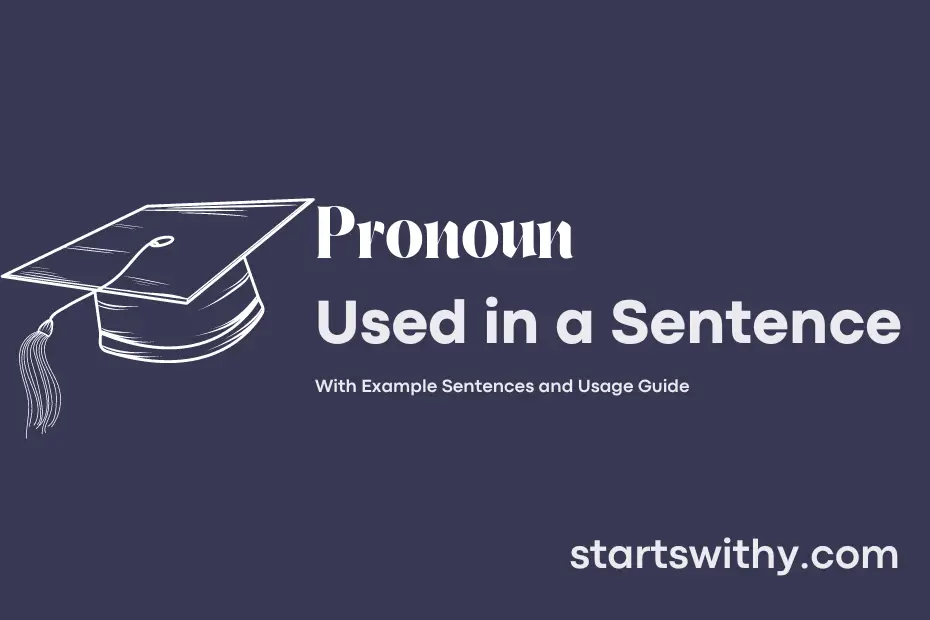Pronouns are a fundamental part of language that help us refer to people, places, or things without constantly repeating their names. They play a crucial role in communication and assist in creating clarity and efficiency in spoken and written language.
By replacing specific nouns in sentences, pronouns simplify language and enhance fluidity in communication. They come in various forms such as personal pronouns, possessive pronouns, demonstrative pronouns, and many more, each serving a unique purpose in sentence structure. Understanding how to properly use pronouns is essential for effective communication in both casual conversations and formal writing.
7 Examples Of Pronoun Used In a Sentence For Kids
- She is playing with her doll.
- He is riding his bicycle.
- They are singing a song together.
- We are reading a book.
- It is a cute puppy.
- You can play with your friends.
- I like to eat ice cream.
14 Sentences with Pronoun Examples
- Pronouns are an essential part of speech that help to avoid repetition in writing.
- In academic writing, it is important to use pronouns effectively to maintain clarity and flow.
- When drafting a research paper, make sure to replace specific nouns with pronouns for smoother transitions.
- Pronouns can vary in gender, number, and case, so it’s crucial to select the appropriate one for your sentence.
- When writing essays, ensure that each pronoun matches its antecedent to avoid confusion for your readers.
- A common mistake students make is using the wrong pronoun when referring to a singular or plural noun.
- Remember to use inclusive language by incorporating gender-neutral pronouns in your academic writing.
- During group discussions, it’s helpful to use pronouns to refer to classmates rather than constantly repeating their names.
- Pronouns play a significant role in establishing the tone and formality of your writing.
- When preparing for exams, focus on mastering the rules for using pronouns correctly in sentences.
- College students often struggle with understanding the different types of pronouns and their functions in sentences.
- Utilizing a variety of pronouns can enhance the readability and engagement of your essays.
- By practicing with sentence exercises, you can improve your proficiency in identifying and using pronouns accurately.
- Always proofread your assignments to ensure that pronouns are used correctly throughout your writing.
How To Use Pronoun in Sentences?
Pronouns are words that are used in place of nouns in a sentence. They help avoid repetition and make sentences more concise. Using pronouns correctly is essential for clear and effective communication.
To use pronouns in a sentence, first identify the noun you want to replace. For example, instead of saying “Mary is happy,” you can say “She is happy,” using the pronoun ‘she’ to replace the noun ‘Mary’.
There are different types of pronouns, each serving a unique purpose. Personal pronouns refer to specific people or things, such as ‘he,’ ‘she,’ and ‘they.’ Possessive pronouns show ownership, like ‘his’ and ‘her.’ Reflexive pronouns are used when the subject and object of a sentence are the same, for example, ‘myself’ and ‘itself.’ Demonstrative pronouns point to specific nouns, such as ‘this’ and ‘those.’
When using pronouns, it is important to ensure they agree in number and gender with the nouns they are replacing. For example, use ‘he’ to replace a singular masculine noun and ‘she’ to replace a singular feminine noun.
Practice using pronouns in your writing and speaking to become more comfortable with them. This will help you communicate more clearly and effectively in everyday conversations or written work.
Conclusion
In conclusion, using sentences with pronouns is a fundamental way to improve the flow and coherence of writing. Pronouns such as “he,” “she,” “it,” or “they” help avoid repetition of nouns and create more graceful, efficient communication. By replacing repetitive nouns with pronouns, sentences become more concise and engaging for readers.
In addition to enhancing readability, sentences with pronouns also promote clarity and cohesion in writing. Pronouns serve as important reference points that connect ideas and maintain consistency throughout a piece of writing. Mastering the use of pronouns allows writers to convey information more effectively and ensure that their message is understood clearly by the audience.



